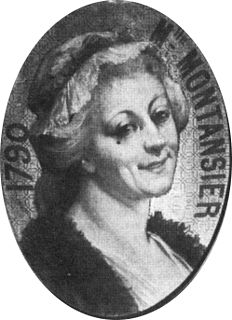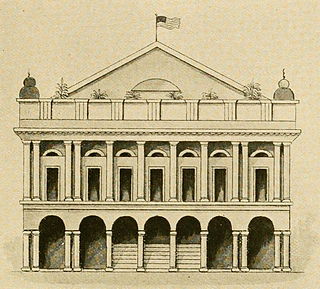Related Research Articles
Jacques Marie Boutet was a French actor and comic playwright from Lunéville. His pseudonym was Monvel. He was a small, thin man without good looks or voice, and yet he became one of the greatest comedians of his time.

The Palais-Royal is a former royal palace located in the 1st arrondissement of Paris, France. The screened entrance court faces the Place du Palais-Royal, opposite the Louvre. Originally called the Palais-Cardinal, it was built for Cardinal Richelieu from about 1633 to 1639 by the architect Jacques Lemercier. Richelieu bequeathed it to Louis XIII, and Louis XIV gave it to his younger brother, Philippe I, Duke of Orléans. Philippe and the succeeding dukes of Orléans made such extensive alterations over the years, almost nothing remains of Lemercier's original design.

The Comédie-Française or Théâtre-Français is one of the few state theatres in France. Founded in 1680, it is the oldest active theatre company in the world. Established as a French state-controlled entity in 1995, it is the only state theatre in France to have its own permanent troupe of actors. The company's primary venue is the Salle Richelieu, which is a part of the Palais-Royal complex and located at 2 rue de Richelieu on the Place André-Malraux in the 1st arrondissement of Paris.
Opéra comique is a genre of French opera that contains spoken dialogue and arias. It emerged from the popular opéras comiques en vaudevilles of the Fair Theatres of St Germain and St Laurent, which combined existing popular tunes with spoken sections. Associated with the Paris theatre of the same name, opéra comique is not necessarily comical or shallow in nature; Carmen, perhaps the most famous opéra comique, is a tragedy.
Plaçage was a recognized extralegal system in French and Spanish slave colonies of North America by which ethnic European men entered into civil unions with non-Europeans of African, Native American and mixed-race descent. The term comes from the French placer meaning "to place with". The women were not legally recognized as wives but were known as placées; their relationships were recognized among the free people of color as mariages de la main gauche or left-handed marriages. They became institutionalized with contracts or negotiations that settled property on the woman and her children and, in some cases, gave them freedom if they were enslaved. The system flourished throughout the French and Spanish colonial periods, reaching its zenith during the latter, between 1769 and 1803.

Pierre-Alexandre Monsigny was a French composer and a member of the French Académie des Beaux-Arts (1813).

Comédie-Italienne or Théâtre-Italien are French names which have been used to refer to Italian-language theatre and opera when performed in France.

Louis Gallodier was a French ballet dancer and choreographer who spent the majority of his career in Sweden, where he was to have a great importance for the development of the ballet in Sweden as the ballet master of the Royal Swedish Ballet.
Minette et Lise was a sister couple of two stage artists, active in Saint Domingue in Pre-revolutionary Haiti. They consisted of Elisabeth Alexandrine Louise Ferrand, stage name "Minette" and Lise. They have become known as Minette et Lise.
Jeanne-Marie Marsan, born Chapiseau, was a French dramatic actress and an opera singer, active in France and Germany in Europe, in the French West Indies and Louisiana. She was the leading actress and opera singer in Saint-Domingue, and later in the first theatre in New Orleans in Louisiana.
Jean Baptiste Fontaine, né Le Sueur, was a French actor and theatre director. He was director of the theatre Comédie du Cap in Cap-Francais and an actor and newspaper editor in New Orleans. He was known under his stage name Fontaine.

Marguerite Brunet, known by her stage name of Mademoiselle Montansier, was a French actress and theatre director.

The Théâtre d'Orléans was the most important opera house in New Orleans in the first half of the 19th century. The company performed in French and gave the American premieres of many French operas. It was located on Orleans Street between Royal and Bourbon. The plans for the theatre were drawn up by Louis Tabary, a refugee from the French colony of Saint-Domingue (Haiti). Construction began in 1806, but the opening was delayed until October 1815. After a fire, it was rebuilt and reopened in 1819, led by another émigré from Saint-Domingue, John Davis. Davis became one of the major figures in French theatre in New Orleans. The theatre was destroyed by fire in 1866, but the ballroom is still used.

Jean-Pierre Solié was a French cellist and operatic singer. He began as a tenor, but switched and became well known as a baritone. He sang most often at the Paris Opéra-Comique. He also became a prolific composer, writing primarily one-act comic operas.
Comédie du Cap was a theater in Cap-Français in Saint-Domingue, active from 1740 to 1793; from 1764 as a public theater. It is regarded as a prototype for the theaters in Saint-Domingue, were theater were immensely popular.
François-Pierre-Auguste Léger was an 18th–19th-century French playwright.

Silvain is a one-act opéra-comique by André Grétry with a libretto by Jean-François Marmontel. It was first performed at the Comédie-Italienne on 19 February 1770 and was one of Grétry's biggest early successes. The plot concerns Silvain, who works as a poor farmer after being disinherited by his rich father for marrying a lower-class woman. The pastoral theme and its celebration of rural life was common in opéra-comique of the time but Marmontel's libretto goes much further in advocating social equality and defending the rights of peasants against the encroachment of landowners.
The Comédie de Port-au-Prince, also called Salle Mesplés, was a theater in Port-au-Prince in Saint-Domingue, active from 1778 to 1791.
Madame Acquaire also known as Mlle Babet, was a French stage actress and theatre director, active in Saint-Domingue.
Mlle Marthe, was a French stage actress and theatre director, active in Saint-Domingue.
References
- ↑ Le Gardeur Jr., Rene J. (1963)"The First New Orleans Theatre, 1792-1803
- ↑ rench Secular Music in Saint-Domingue (1750-1795)
- ↑ Juliane Braun: Creole Drama: Theatre and Society in Antebellum New Orleans
- ↑ Juliane Braun: Creole Drama: Theatre and Society in Antebellum New Orleans
- John G. Cale, French Secular Music in Saint-Domingue (1750-1795) Viewed as a Factor in America's Musical Growth , Louisiana State University and Agricultural & Mechanical College, 1971
- Kendall's History of New Orleans, Chapter 45